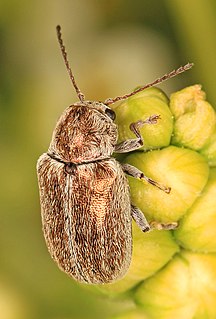
Biological databases are libraries of biological sciences, collected from scientific experiments, published literature, high-throughput experiment technology, and computational analysis. They contain information from research areas including genomics, proteomics, metabolomics, microarray gene expression, and phylogenetics. Information contained in biological databases includes gene function, structure, localization, clinical effects of mutations as well as similarities of biological sequences and structures.

The Integrated Taxonomic Information System (ITIS) is an American partnership of federal agencies designed to provide consistent and reliable information on the taxonomy of biological species. ITIS was originally formed in 1996 as an interagency group within the US federal government, involving several US federal agencies, and has now become an international body, with Canadian and Mexican government agencies participating. The database draws from a large community of taxonomic experts. Primary content staff are housed at the Smithsonian National Museum of Natural History and IT services are provided by a US Geological Survey facility in Denver. The primary focus of ITIS is North American species, but many biological groups exist worldwide and ITIS collaborates with other agencies to increase its global coverage.
The Catalogue of Life is an online database that provides an index of known species of animals, plants, fungi, and microorganisms. It was created in 2001 as a partnership between the global Species 2000 and the American Integrated Taxonomic Information System. The Catalogue is used by research scientists, citizen scientists, educators, and policy makers. The Catalogue is also used by the Biodiversity Heritage Library, the Barcode of Life Data System, Encyclopedia of Life, and the Global Biodiversity Information Facility. The Catalogue currently compiles data from 165 peer-reviewed taxonomic databases that are maintained by specialist institutions around the world. As of September 2022, the COL Checklist lists 2,067,951 of the world's 2.2m extant species known to taxonomists on the planet at present time.

The Ropalomeridae are a family of acalyptrate flies.
Glyptoscelis juniperi is a species of leaf beetle. It is found in California in the United States.

Glyptoscelis is a genus of leaf beetles in the subfamily Eumolpinae. There are 38 species of Glyptoscelis described from North, Central and South America. There are also three species of Glyptoscelis known from the West Indies, though they are wrongly placed in the genus. In addition, a single species was described from Hunan, China in 2021.

Chilocorus cacti, known generally as the cactus lady beetle or the twice-stabbed cactus lady beetle, is a species of lady beetle in the family Coccinellidae. It is native to the Caribbean region, North America, Central America, and South America. The adults and larvae feed on scale insects and attempts have been made to use it for biological pest control.
Graphops comosa, known generally as the Monahans sandhill chrysomelid or long-haired graphops, is a species of leaf beetle. It is found in southeast New Mexico and the adjacent region of Texas.
Glyptoscelis albicans is a species of leaf beetle. It is found in the southeastern United States.
Glyptoscelis alternata is a species of leaf beetle. It is found in the western United States.
Metachroma pellucidum is a species of leaf beetle. It is mostly found in coastal states of the United States, ranging from Texas to Florida to New York, but is also found inland to Indiana. Its length is between 3.4 and 3.8 mm.
Metachroma floridanum is a species of leaf beetle. Its distribution ranges from Florida to North Carolina in the United States.
Neoempheria illustris is a species of fungus gnats in the family Mycetophilidae.
Curicta is a genus of waterscorpions in the family Nepidae native to freshwater habitats in the Americas. There are more than 15 species, with most restricted to South America. There are only two species in the United States: C. pronotata and C. scorpio.

Monocesta is a genus of skeletonizing leaf beetles and flea beetles in the family Chrysomelidae. There are at least three described species in Monocesta.
Glyptoscelis prosopis is a species of leaf beetle. Its range spans from southern Texas to Mexico and Central America. It was first described by the American entomologist Charles Frederic August Schaeffer in 1905.
Glyptoscelis pubescens, known generally as the hairy leaf beetle or pine chrysomelid, is a species of leaf beetle. It is found in eastern North America. It is a potential pest of pine trees.
Glyptoscelis albida is a species of leaf beetle. It is found in western North America.
Glyptoscelis cryptica is a species of leaf beetle. It is found in the central United States.
Glyptoscelis squamulata, the grape bud beetle, is a leaf beetle. The species was first described by George Robert Crotch in 1873. It is found in the western United States.





